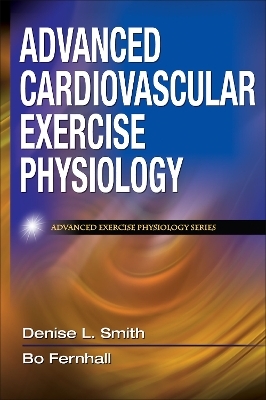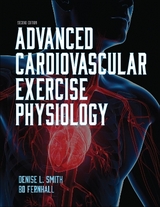
Advanced Cardiovascular Exercise Physiology
Human Kinetics (Verlag)
978-0-7360-7392-9 (ISBN)
- Titel erscheint in neuer Auflage
- Artikel merken
Written for students and professionals working within exercise science and related health professions, AdvancedCardiovascular Exercise Physiology systematically details the effect of acute and chronic exercise training on each component of the cardiovascular system: the heart, the vasculature, and the blood (including blood clotting factors). Readers will gain a comprehensive understanding of the cardiovascular system and learn how to apply this knowledge to their work with athletes, other active individuals, and patients who have cardiovascular risk factors.
Advanced Cardiovascular Exercise Physiology highlights the complex interaction of the components of the cardiovascular system both at rest and during exercise. Using the latest scientific and medical research, this text presents engaging discussion of cardiovascular responses and adaptions to both acute and chronic aerobic and resistance exercise training. In addition, specific attention is paid to the beneficial effects of exercise on the components of the cardiovascular system and the mechanisms through which regular exercise provides cardioprotection.
Each chapter contains a summary to highlight key content, important terms bolded within the text for quick reference, and a key terms section at the end of each chapter defining all the bolded terms. In addition, sidebars within each chapter describe real-world examples and applications. Richly illustrated, Advanced Cardiovascular Exercise Physiology uses extensive figures and graphics to elucidate physiological mechanisms and to depict exercise responses and training adaptations.
This text is divided into two sections, beginning with a concise explanation of the structure and function of each component of the cardiovascular system. In the second section, readers encounter detailed discussion of the acute and chronic effects of aerobic and resistance exercise on cardiac function, vascular function, and hemostatic variables.
Advanced Cardiovascular Exercise Physiology provides a framework for understanding how the components of the cardiovascular system cooperate to support exercise and how those components adapt to and benefit from a systematic program of exercise training. By presenting current research that elucidates the specific effects and benefits of exercise on the cardiovascular system, Advanced Cardiovascular Exercise Physiology also offers readers possible future directions for research.
Human Kinetics’ Advanced Exercise Physiology series offers books for advanced undergraduate and graduate students as well as professionals in exercise science and kinesiology. These books highlight the complex interaction of the various systems both at rest and during exercise. Each text in this series offers a concise explanation of the system and details how each is affected by acute exercise and chronic exercise training. Advanced Cardiovascular Exercise Physiology is the second volume in the series.
Denise L. Smith, PhD, is a professor in the department of health and exercise sciences and the class of 1961 term professor at Skidmore College. She also holds an appointment as a research scientist at the University of Illinois Fire Service Institute. She received her PhD from the University of Illinois in exercise physiology in 1990. For nearly two decades, Smith has conducted scientific research on cardiovascular responses to exercise. Her research is focused on the physiological strain associated with heat stress, with a specific emphasis on cardiovascular and thrombotic responses to firefighting. She has led several federally funded research projects dealing with the cardiovascular strain of firefighting. Smith has published studies on heat stress, cardiovascular function, and the physiological aspects of firefighting in numerous peer-reviewed scientific journals, including the American Journal of Cardiology, Medicine and Science inSports and Exercise, Ergonomics, Journal of Thermal Biology, and Aviation, Space and Environmental Medicine. Smith has collaborated extensively with fire service organizations, has served in leadership roles in the American College of Sports Medicine, and is a member of the American Physiological Society. Bo Fernhall, PhD, is a professor in the department of kinesiology and community health at the University of Illinois at Urbana-Champaign. He received his PhD in exercise physiology from Arizona State University in 1984. Fernhall has nearly 30 years of experience in cardiovascular research, with a current focus on how exercise and diet affect heart, arterial, and autonomic function. He also directed cardiovascular rehabilitation programs for over 20 years, combining research and clinical experience. Fernhall is a fellow of the American Heart Association, the American Association of Cardiopulmonary Rehabilitation, and the American College of Sports Medicine. He was elected to the American Academy of Kinesiology and Physical Education in 2005. He has won several national research awards, most recently the G. Lawrence Rarick National Research Award in 2006 for his research on the benefits of exercise in people with disabilities. Fernhall has published over 160 peer-reviewed manuscripts in scientific journals, including the American Journal of Cardiology, Amercan Journal of Hypertension, American Journal of Physiology, Atherosclerosis, European Heart Journal, and Medicine and Science in Sports and Exercise.
Section I: Cardiovascular Physiology
Chapter 1: Essentials of the Cardiovascular System
Components of the Cardiovascular System
Cardiovascular Response to Exercise
Summary
Chapter 2: Heart as a Pump
Gross Anatomy of the Heart
Cardiac Cycle
The Ventricular Pressure-Volume Loop
Cardiac Output
Distribution of Cardiac Output
Coronary Blood Supply
Measuring Cardiac Function
Summary
Chapter 3: Cardiac Myocytes
Microscopic Anatomy of Cardiac Myocyte
Excitation Contraction Coupling (ECC)
Mechanisms of Contraction
Metabolic Requirements
Summary
Chapter 4: Electrical Activity of the Heart
Ion Basis of Electrical Activity
Resting Membrane Potential
Action Potential
Conduction System of the Heart
Autorhythmicity of Conduction Cells
Pacemakers of the Heart
Control of Heart Rate
Other Heart Rate Control Mechanisms
Heart Rate Variability
Summary
Chapter 5: The Electrocardiogram
The ECG Tracing
Measuring the ECG
Measuring heart rate
Cardiac rhythms
ST-Segment Changes (Ischemia)
Summary
Chapter 6: Hemodynamics and Peripheral Circulation
The Pressure Differential
Flow Velocity
Poiseuille’s Law
Blood Flow
Arterial Blood Pressure
Pulse Waves and Wave Reflections
Blood Pressure Measurement
Control of Vasoconstriction and Vasodilatation
Reflex Control of Blood Pressure and Vasomotion
Summary
Chapter 7: Vascular Structure and Function
Structure of Blood Vessels
Vascular Network
Endothelium
Endothelium Regulation of Vascular Tone
Vascular Smooth Muscle
Measuring Endothelial and Vascular Function
Summary
Chapter 8: Hemostasis: Coagulation and Fibrinolysis
Vascular Injury
Platelets
Coagulation
Fibrinolysis
Assessing Hemostasis
Summary
Section II: Exercise Physiology
Chapter 9: Cardiovascular Responses to Acute Aerobic Exercise
Cardiac Responses to Acute Aerobic Exercise
Vascular Response to Acute Aerobic Exercise
Hemostatic Responses to Acute Aerobic Exercise
Summary
Chapter 10: Cardiovascular Adaptations to Aerobic Training
Cardiac Adaptations to Aerobic Training
Vascular Adaptations to Aerobic Training
Hemostatic Adaptations to Aerobic Training
Summary
Chapter 11: Cardiovascular Responses to Acute Resistance Exercise
Cardiac Responses to Acute Resistance Exercise
Vascular Response to Acute Resistance Exercise
Hemostatic Responses to Acute Resistance Exercise
Summary
Chapter 12: Cardiovascular Adaptations to Resistance Training
Cardiac Adaptations to Resistance Training
Vascular Function
Hemostatic Adaptations With Resistance Training
Summary
| Erscheint lt. Verlag | 9.12.2010 |
|---|---|
| Verlagsort | Champaign, IL |
| Sprache | englisch |
| Maße | 178 x 254 mm |
| Gewicht | 680 g |
| Themenwelt | Studium ► 1. Studienabschnitt (Vorklinik) ► Physiologie |
| Naturwissenschaften ► Biologie ► Humanbiologie | |
| ISBN-10 | 0-7360-7392-2 / 0736073922 |
| ISBN-13 | 978-0-7360-7392-9 / 9780736073929 |
| Zustand | Neuware |
| Haben Sie eine Frage zum Produkt? |
aus dem Bereich



